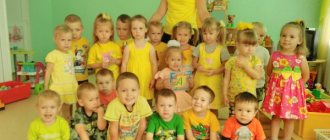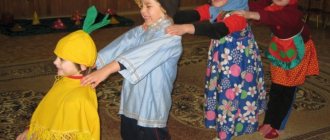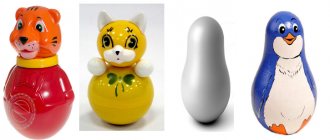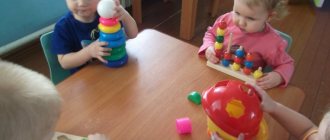Junior group. Early childhood, nursery. Children 1-4 years old
Project on environmental education of preschool children “Our Trees” (second junior group) Introduction Environmental education is one of the main directions in the education system; it is a way of influencing children’s feelings, their consciousness, views and ideas. Children feel the need to communicate with nature. They learn to love nature, observe, empathize, understand,...
Ecological project “These amazing insects” for children 4–5 years old Environmental project : “These amazing insects”
“Just as the huge sun sparkles and shimmers with all its colors in a drop of morning dew, so in any tiny bug, in any inconspicuous insect, the wealth, beauty and endless diversity of the vast world are reflected...
Environmental project in the second junior group “Green Pets”
Olga Skripnik
Environmental project in the second junior group “Green Pets”
Project type : research, short-term, group .
The goal of the project : to create conditions for the comprehensive development of a younger preschooler , his environmental education through familiarization with plant life.
Project objectives :
1. To consolidate children’s knowledge about plants: indoor and flowering herbaceous plants;
2. To teach to notice the beauty of surrounding plants, to give an idea of the flowerbed, of the plants that a person plants for beauty;
3. Cultivate a kind attitude, responsiveness, and love for all living things, including plants. Teach children to provide all possible assistance in caring for plants;
4. Develop an interest in nature, introduce the rules of behavior in nature (do not tear plants unnecessarily, do not break tree branches)
.
Project implementation period : from August 13 to August 17, 2018.
I. Preparatory – August 13;
II. Main – August 14-16;
III. The final one is August 17.
project implementation activities :
1. Reading poems, nursery rhymes, songs, riddles about plants.
2. Thematic lesson: “Flowers on the window, flowers outside the window”
.
3. Design of the photo exhibition “Flowers: indoor, field, garden...”
4. Planting indoor plant sprouts in a pot. Productive activity: sculpting “Flower in a Pot”
.
5. Watering and weeding flowers in flower beds. Productive activity: application “Blossoming Flowerbed”
(team work)
.
6. Consultation for parents “On the benefits of indoor plants”
.
Project implementers : teacher of the second junior group , children of the second junior group , parents.
Expected final results:
1. Expand children’s horizons about indoor, field, and garden plants.
2. Enrichment and activation of children's vocabulary.
3. The joint activities of children, teachers, and parents bring them together in achieving the common goal of raising harmoniously developed children.
4. Search work and its result: printed materials (albums: “Indoor flowers”
,
“Garden Flowers”
,
“Wild Flowers”
;
Lotto “Plant Parts”
, replenishing a corner of nature with new
“
green pets ” .
The formation of the initial foundations of ecological culture is the accumulation of specific, sensory ideas about objects and natural phenomena that surround children and are part of their life activity.
start environmental education in a preschool institution from the moment children enter the first junior group . Children 2-3 years old are trusting and spontaneous, easily involved in practical activities together with adults, and enjoy manipulating various objects. Their involuntary and short-lived attention is easily focused by any novelty: an unexpected action, a new object or toy. It should be remembered that at this age children cannot do one thing for a long time, focus on one thing for a long time - they need a constant change of events, frequent changes of impressions. An adult must understand that words are an abstraction and they must be backed by a visual image of an object and actions with them - only in this case do small children begin to respond to the teacher’s speech.
An important aspect of environmental education at this age stage is the formation of children’s understanding of the specifics of a living object, its fundamental difference from an object (inanimate object), the formation of elementary skills of correct interaction with plants, participation in activities to create the necessary conditions for them. Familiarization with natural objects and their parts , the main properties are the formation of initial ecological ideas , which are the basis for the correct attitude towards living beings, correct interaction with them. Knowledge is important not in itself, but for developing a differentiated vision of natural objects and the ability to act with them. Correct attitude towards living things creatures, which is the end result, an indicator of environmental education , manifests itself at this age only in the voluntary and active participation of children in joint activities with adults aimed at maintaining the conditions necessary for the inhabitants of the green zone and communicating with them. Such activities should be colored by the children’s positive emotions and active perception of everything that the teacher says and does.
Problem: The need to develop children's interest in objects of the plant world, teach them to be inquisitive and observant. Instill love and respect for all living things, including through caring for plants.
Target groups of the project and their interests :
Children 3-4 years old – development of cognitive interest in the world around them;
Parents - participation in the life of the group ;
Teacher - realization of creative potential, drawing attention to the problem of environmental education of preschool children, increasing the rating of a preschool educational institution.
Project implementation mechanism .
The first stage is preparatory (August 13)
:
Defining the topic, goals, objectives, project , predicting the result;
Discussion with parents of the project , identification of opportunities, funds necessary for the implementation of the project , determination of the content of the activities of all project ;
Search for different means of achieving goals.
The second stage is the main one (August 14-16)
:
Reading poems, nursery rhymes, songs, riddles about plants.
Thematic lesson: “Flowers on the window, flowers outside the window”
.
Planting indoor plant sprouts in a pot. Productive activity: sculpting “Flower in a Pot”
.
Watering and weeding flowers in flower beds. Productive activity: application “Blossoming Flowerbed”
(team work)
.
Consultation for parents “On the benefits of indoor plants”
.
The third stage is the final one (August 17)
:
Design of the photo exhibition “Flowers: indoor, field, garden...”
Analysis and classification of collected material;
1. Expand children’s horizons about indoor, field, and garden plants.
2. Enrichment and activation of children's vocabulary.
3. The joint activities of children, teachers, and parents bring them together in achieving a common goal.
4. Participation of families of pupils in the educational process.
The work done achieved its goal. Children developed an interest in the world around them, in their native nature. The desire to take care of “ green pets ”
.
Environmental project in the second junior group “Vegetable garden on the windowsill” Environmental project “Vegetable garden on the window” in the 2nd junior group. PROJECT PASSPORT Author of the project: teacher of the second junior group Archipenko Anzhelika.
Environmental project in the second junior group “Green Pets”
Irina Vasilievna
Environmental project in the second junior group “Green Pets”
Municipal budgetary preschool educational institution
"Zelenodolsk kindergarten "Beryozka"
Environmental project in the second junior group
«Green pets»
Compiled by teacher Dubasova. I.V.
S. Green Dol 2020
Environmental project in the second junior group “ Green Pets ”
Project type : research, short-term, group .
The goal of the project : to create conditions for the comprehensive development of a younger preschooler , his environmental education through familiarization with plant life.
Project objectives :
1. To consolidate children’s knowledge about plants: indoor and flowering herbaceous plants;
2. To teach to notice the beauty of surrounding plants, to give an idea of the flowerbed, of the plants that a person plants for beauty;
3. Cultivate a kind attitude, responsiveness, and love for all living things, including plants. Teach children to provide all possible assistance in caring for plants;
4. Develop an interest in nature, introduce the rules of behavior in nature (do not tear plants unnecessarily, do not break tree branches)
.
Project implementation period : from April 1 to April 5, 2016
I. Preparatory – April 1;
II. Main – April 2-4;
III. The final one is April 5.
project implementation activities :
1. Reading poems, nursery rhymes, songs, riddles about plants.
2. Thematic lesson: “Flowers on the window, flowers outside the window”
.
3. Design of the photo exhibition “Flowers: indoor, field, garden...”
4. Planting Coleus cuttings in a pot. Productive activity: sculpting “Flower in a Pot”
.
5. Sowing marigold seeds into a tray for seedlings. Productive activity: application “Blossoming Flowerbed”
(team work)
.
6. Consultation for parents “Are plants needed in the house?”
.
Project implementers : teachers of the second junior group , children of the second junior group , parents.
Expected final results:
1. Expand children’s horizons about indoor, field, and garden plants.
2. Enrichment and activation of children's vocabulary.
3. The joint activities of children, teachers, and parents bring them together in achieving the common goal of raising harmoniously developed children.
4. Search work and its result: printed materials (albums: “Indoor flowers”
,
“Garden Flowers”
,
“Wild Flowers”
;
Lotto “Plant Parts”
, replenishing a corner of nature with new
“
green pets ” .
The formation of the initial foundations of ecological culture is the accumulation of specific, sensory ideas about objects and natural phenomena that surround children and are part of their life activity.
start environmental education in a preschool institution from the moment children enter the first junior group . Children 2-3 years old are trusting and spontaneous, easily involved in practical activities together with adults, and enjoy manipulating various objects. Their involuntary and short-lived attention is easily focused by any novelty: an unexpected action, a new object or toy. It should be remembered that at this age children cannot do one thing for a long time, focus on one thing for a long time - they need a constant change of events, frequent changes of impressions. An adult must understand that words are an abstraction and they must be backed by a visual image of an object and actions with them - only in this case do small children begin to respond to the teacher’s speech.
An important aspect of environmental education at this age stage is the formation of children’s understanding of the specifics of a living object, its fundamental difference from an object (inanimate object), the formation of elementary skills of correct interaction with plants, participation in activities to create the necessary conditions for them. Familiarization with natural objects and their parts , the main properties are the formation of initial ecological ideas , which are the basis for the correct attitude towards living beings, correct interaction with them. Knowledge is important not in itself, but for developing a differentiated vision of natural objects and the ability to act with them. Correct attitude towards living things creatures, which is the end result, an indicator of environmental education , manifests itself at this age only in the voluntary and active participation of children in joint activities with adults aimed at maintaining the conditions necessary for the inhabitants of the green zone and communicating with them. Such activities should be colored by the children’s positive emotions and active perception of everything that the teacher says and does.
Problem: The need to develop children's interest in objects of the plant world, teach them to be inquisitive and observant. Instill love and respect for all living things, including through caring for plants.
Target groups of the project and their interests :
Children 3-4 years old – development of cognitive interest in the world around them;
Parents - participation in the life of the group ;
Teachers - realizing creative potential, drawing attention to the problem of environmental education of preschool children, increasing the rating of preschool educational institutions.






